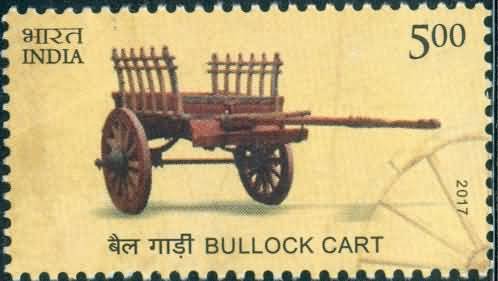Bullock Cart

Technical Data
| Stamp Set | Means of Transport |
|---|---|
| Date of Issue | March 25, 2017 |
| Denomination | Rs. 5 |
| Quantity | 3,000 |
| Perforation | 13 |
| Printer | India Security Press, Nashik |
| Printing Process | Wet Offset |
| Watermark | No Watermark |
| Colors | Multicolor |
| Credit (Designed By) | Sh. Brahm Prakash |
| Catalog Codes |
Michel IN 3131 Yvert et Tellier IN 2822 Stanley Gibbons IN 3285 |
| Themes | Transport |
Introduction
The Bullock Cart is one of India’s oldest and most iconic modes of transport. For centuries, it served as a primary means of travel and goods transportation, especially in rural areas. Pulled by oxen, the bullock cart reflects India’s agricultural lifestyle, traditional wisdom, and sustainable mobility practices.
Historical Background
Bullock carts have been used in India since ancient times and are closely linked with the development of rural civilization. They provided an efficient and economical way to transport people and agricultural produce across villages and towns. Even today, they are used in places where modern vehicles are expensive or where terrain does not support them.
Structure and Design
A Bullock Cart is typically a two-wheeled wooden vehicle drawn by a pair of oxen. It consists of:
- A wooden platform or seating space
- A long shaft and yoke connecting the cart to the bullocks
- Large wheels designed to navigate uneven rural roads
In some regions, four-wheeled bullock carts are also used. The design varies across states based on available materials and local culture.
Role in Rural Transportation
The bullock cart played a crucial role in shaping rural transportation by enabling:
- Transport of agricultural goods to markets
- Movement of families for social, cultural and religious events
- Carriage of household items and construction materials
Before the introduction of modern vehicles, it was the lifeline of rural mobility.
Cultural Significance
The Bullock Cart holds a special place in India’s cultural heritage. It features in folk songs, art, literature, and rural celebrations. During festivals and fairs, bullock carts are often decorated and used in processions. In some regions, bullock cart races still take place as a traditional sporting event.
Eco-Friendly Mode of Transport
The bullock cart is a sustainable and non-polluting means of transportation. Operating without fuel, it represents an early form of eco-friendly mobility and continues to be valued in regions that prioritize traditional and natural living.
Legacy
While modern transport has reduced the everyday use of bullock carts, they remain an enduring symbol of rural India, simplicity, and self-sustained living. Their continued presence reflects the timeless bond between agriculture, tradition, and community life.
